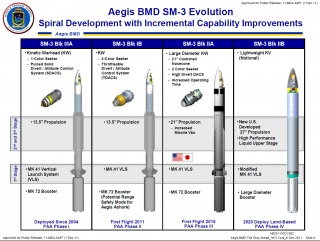Get Ready, Russia and China: The U.S. Navy Has Big Missile Defense Plans
The Navy is both modernizing current Aegis technology on board existing ships and also building upgrades into ships now under construction.
Aegis radar, a technology now on destroyers and cruisers, is aimed at providing terminal phase ballistic missile defense and an ability to knock out or intercept attacking enemy cruise missiles.
The Navy is modernizing its destroyers and cruisers with Aegis radar technology equipped with new multi-mission signal processors, kill assessment systems, radio frequency upgrades and various on-board circuits, service officials said.
The upgrades are part of an intense service effort to better arm its fleet of destroyers and cruisers with modernized Aegis radar technologies engineered to both help the ships better attack adversaries and defend against enemy missiles.
Aegis radar, a technology now on destroyers and cruisers, is aimed at providing terminal phase ballistic missile defense and an ability to knock out or intercept attacking enemy cruise missiles.
Raytheon has been awarded a $20 million deal extension to perform these Aegis upgrades.
The Navy is both modernizing current Aegis technology on board existing ships and also building upgrades into ships now under construction. These new upgrades are designed to build upon the most current iteration of Aegis technology, called Baseline 9.
The Aegis modernization program hope to achieve combat system upgrades that will enhance the anti-air warfare and ballistic missile defense capabilities of Aegis-equipped DDG 51 Arleigh Burke-class destroyers and CG 47 Ticonderoga-class cruisers.
aytheon has been awarded a $20 million deal extension to perform these Aegis upgrades.
The Navy is both modernizing current Aegis technology on board existing ships and also building upgrades into ships now under construction. These new upgrades are designed to build upon the most current iteration of Aegis technology, called Baseline 9.
The Aegis modernization program hope to achieve combat system upgrades that will enhance the anti-air warfare and ballistic missile defense capabilities of Aegis-equipped DDG 51 Arleigh Burke-class destroyers and CG 47 Ticonderoga-class cruisers.
The NIFC-CA technology can, in concept, be used for both defensive and offensive operations, Navy officials have said.
Having this capability could impact Pentagon discussion about how potential adversaries could use long-range weapons to threaten the U.S. military and prevent its ships from operating in certain areas -- such as closer to the coastline.
Having NIFC-CA could enable surface ships, for example, to operate more successfully closer to the shore of potential enemy coastlines without being deterred by the threat of long-range missiles.
Defensive applications of NIFC-CA would involve detecting and knocking down an approaching enemy anti-ship missile, whereas offensive uses might include efforts to detect and strike high-value targets from farther distances than previous technologies could.
The possibility for offensive use parallels with the Navy’s emerging “distributed lethality” strategy, wherein surface ships are increasingly being outfitted with new or upgraded weapons.
The new strategy hinges upon the realization that the U.S. Navy no longer enjoys the unchallenged maritime dominance it had during the post-Cold War years.
During the years following the collapse of the former Soviet Union, the U.S. Navy shifted its focus from possibly waging blue-water combat against a near-peer rival to focusing on things such as counter-terrorism, anti-piracy and Visit, Board Search and Seizure, or VBSS, techniques.
More recently, the Navy is again shifting its focus toward near-peer adversaries and seeking to arm its fleet of destroyers, cruisers and Littoral Combat Ships with upgraded or new weapons designed to increase its offensive fire power.
ris Osborn became the Managing Editor of Scout Warrior in August of 2015. His role with Scout.com includes managing content on the Scout Warrior site and generating independently sourced original material. Scout Warrior is aimed at providing engaging, substantial military-specific content covering a range of key areas such as weapons, emerging or next-generation technologies and issues of relevance to the military. Just prior to coming to Scout Warrior, Osborn served as an Associate Editor at the Military.com. Osborn previously served at the Pentagon as a Highly Qualified Expert with the Office of the Assistant Secretary of the Army - Acquisition, Logistics & Technology. Osborn has also worked as an anchor and on-air military specialist at CNN and CNN Headline News. This story originally appeared in Scout Warrior.

